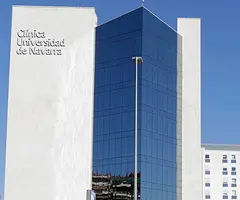Craniopharyngioma
"The treatment approach for patients with a craniopharyngioma must be carried out by a team of different specialties in order to offer the patient the best alternative that achieves complete removal of the tumor without neurological damage".
DR. BARTOLOMÉ BEJARANO
SPECIALIST. NEUROSURGERY DEPARTMENT

Craniopharyngioma is a rare, benign brain tumour, usually occurring just above the pituitary gland. Craniopharyngiomas form from tissues that, in the embryonic stage, linked the brain to the pharynx.
In general, the prognosis for patients with craniopharyngioma is good, with the possibility of complete cure in 80-90% of cases, if the tumour can be completely removed by surgery or treated with high doses of radiotherapy.
Good prognostic criteria for radical surgery are: age less than 5 years, small tumours without hypothalamic symptoms, intrasellar or pure intraventricular location, experience of the surgeon.

A PERSONALIZED MEDICINE
Second Opinion,
peace of mind
Request a second opinion from our professionals with great experience in the diagnosis and treatment of oncological diseases
In 3 days, without leaving home.
What are the symptoms of uterine cancer?
Hydrocephalus
If the tumour obstructs the third ventricle, fluid may accumulate in the brain, increasing intracranial pressure and causing headaches, nausea or vomiting.
Visual disturbances
Due to pressure on the optic chiasm and optic tracts, which may result in partial or progressive loss of vision.
Galactorrhoea
In some cases, impaired regulation of prolactin by the hypothalamus can cause abnormal milk secretion in men and women.
Diabetes insipidus
Occurs when the tumour affects the hypothalamus, disrupting the production of antidiuretic hormone, causing excessive urination and intense thirst.
Stunted growth
It is caused by a decrease in growth hormone due to pituitary involvement, which prevents normal development in children and adolescents.
Do you have any of these symptoms?
If you suspect that you have any of the above symptoms,
you should consult a medical specialist for a diagnosis.
How is craniopharyngioma diagnosed?
Diagnosis of craniopharyngioma is made by neurological examination and brain MRI.
The lesions are usually lobulated, compressing the III ventricle, and of mixed solid-cystic characteristics, with contrast uptake in the solid portion.
How is craniopharyngioma treated?
These are symptomatic benign (expanding) tumors and metastasis is rare.
Although the complete removal of these tumors is curative, it is often impossible to perform a total resection without neurological deficits, so it is often necessary to design a therapeutic strategy combining microsurgery, stereotactic puncture of the cysts by injecting substances that obliterate the cysts, radiosurgery and, in selected cases, conventional radiotherapy.
Where do we treat it?
IN NAVARRA AND MADRID
Central Nervous System Tumors Area
of the Cancer Center Clínica Universidad de Navarra
In the Central Nervous System Tumors Area we offer maximum safety and efficiency in brain tumor surgery, being the first hospital with a high field magnetic resonance within the operating room.
We have a highly specialized team in the surgery of brain tumors, with more than 15 years of experience.
The individualized treatment of each case by an interdisciplinary team allows us to offer the best alternative to each patient.

Why at the Clinica?
- Integral evaluation of the patient.
- Cutting edge technology.
- Expert professionals who are a national reference.



























